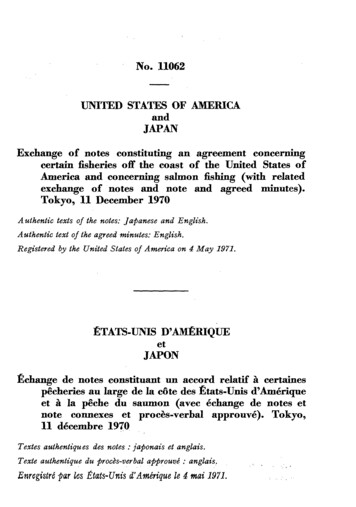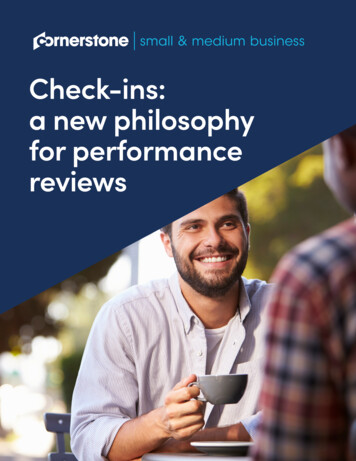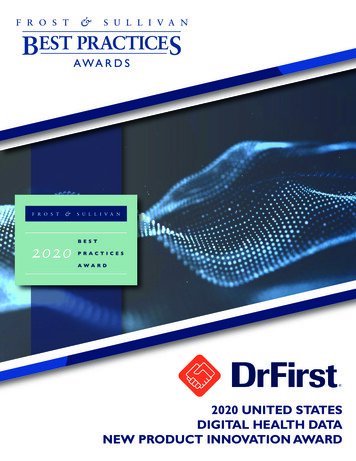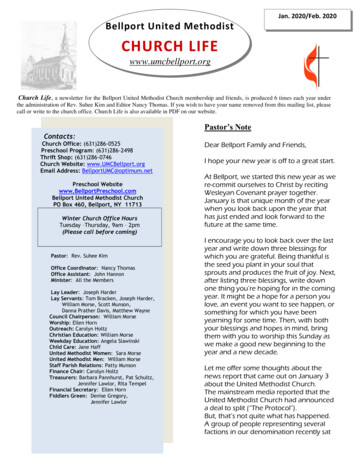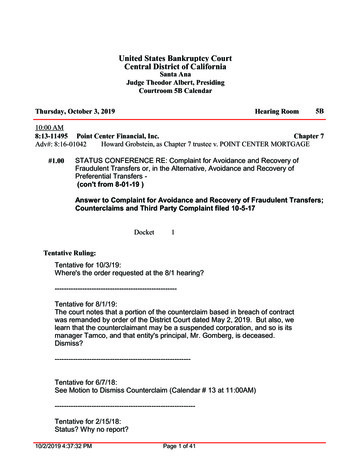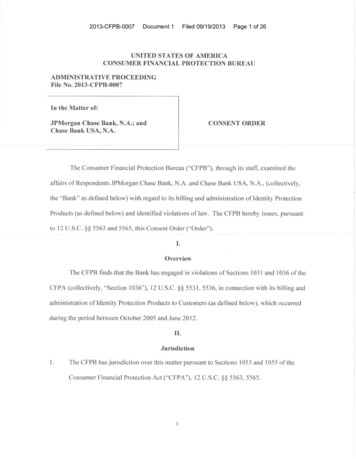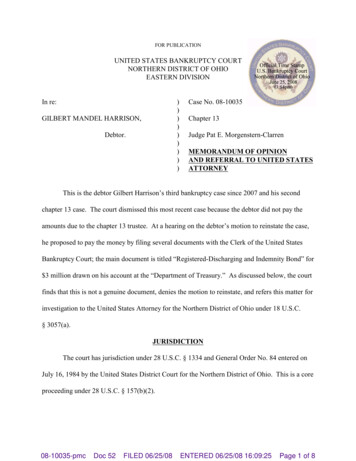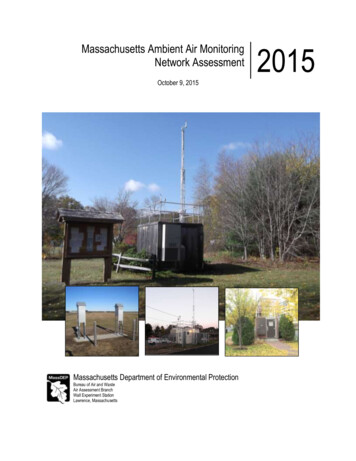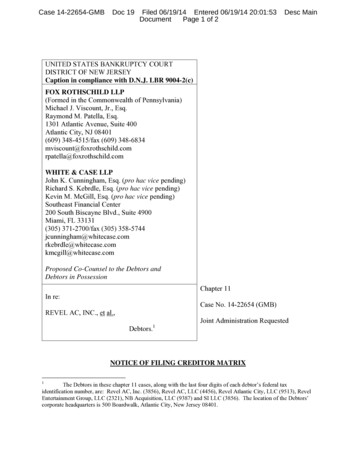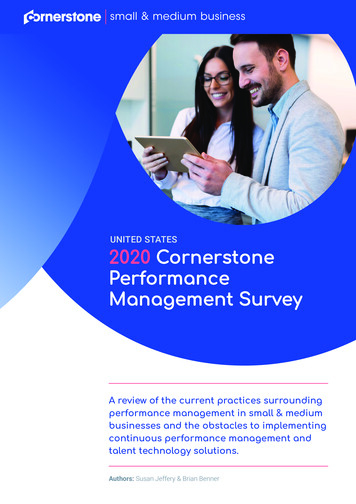
Transcription
UNITED STATES2020 CornerstonePerformanceManagement SurveyA review of the current practices surroundingperformance management in small & mediumbusinesses and the obstacles to implementingcontinuous performance management andtalent technology solutions.Authors: Susan Jeffery & Brian Benner
2020 CORNERSTONE PERFORMANCE MANAGEMENT SURVEYTable ofContentsExecutive Summary. 03Key Findings . 04Introduction. 05Survey Questions & FeedbackPerformance reviews are business, and not employee, centric.06SMBs are in transition with performance reviews.09Managers lack the time, skills, and tools for continuous performance management.13Adoption of automation & enablement tools remains low.15Conclusion. 17About Cornerstone. 182
2020 CORNERSTONE PERFORMANCE MANAGEMENT SURVEYExecutive Summary95% of managers are not satisfied with theircompany’s annual performance managementprocess and 75% of employees see yearlyreviews as unfair1.Performance reviews are broken.It’s not that employees don’t need feedback.They do. In fact, statistics consistently showthe correlation between creating a culture ofcontinuous feedback and increased employeeengagement, productivity, and retention whichimpact business goals and, ultimately, thecompany’s bottom line.To better understand the current state ofemployee feedback in businesses under 1,000employees, Cornerstone conducted a surveyasking questions on performance reviewpractices, priorities, and obstacles.Findings of the survey illustrated:»Performance reviews are largely companycentric rather than employee focused with25% listing alignment to business goalsas the primary reason for conductingperformance reviews and 18% forcompensation review.»Employees who receive frequent feedback are3.6 times more likely to strongly agree thatthey are motivated to do outstanding work»Performance feedback: 26% of respondentsprovide employee feedback annually, 18%quarterly, 17% monthly, 16% every two weeks.»Employees who receive frequent feedback are3.0 times more likely to be engaged at work»»42% of millennials have reported they would likelyleave a job if they weren’t learning fast enoughLearning & Development: 26% of respondentsmeet with employees only once per year.19% quarterly and 14% bi-annually.»The most common listed obstacles tocontinuous performance managementare time constraints, lack of structuresurrounding feedback, and limited coachingskills.»45% of respondents record employeefeedback meetings via spreadsheets, Worddocuments, or other manual processes.»41% of respondents said managers areslightly or not at all effective at buildingactionable performance goals for teammembers.A consistent driver for employeeengagement, productivity,and retention is feedback anddevelopment opportunities.The value of continuous performancemanagement (CPM) and developmentopportunities has been proven by research, butCornerstone wanted to understand how, and if,theory has been implemented into practice bysmall & medium businesses. Are SMBs usingCPM? What methods of feedback are theyusing and how effective are they?1Findings supported the conclusion that SMBsare trying to provide feedback more often, butare struggling with how to make the feedbackvaluable with structure and tools to guidemanagers in ews.aspx3
2020 CORNERSTONE PERFORMANCE MANAGEMENT SURVEYKey Findings from SurveyGen Z, iGen, orCentennialsBorn 1996 or afterMillennial orGeneration YBorn 1977 – 1995Generation XBorn 1965 – 1976Baby BoomersBorn 1946 – 1964Traditionalists orSilent GenerationBorn 1945 & before26%providefeedbackannually45%record employeefeedbackmeetingsvia manualprocessesWhat is thedemographicof theirworkersWhichgenerationvalues feedbackthe most?Top 3 reasonfor conductingperformancereviews:17%12%133%26%Create & maintainalignment tobusiness goals46%2Compensation /remuneration review27%19%14%5%1%93%say managersare too busy toprovide regularcheck-ins13%provideonly verbalfeedback3Drive employeeengagement41%say a lack ofstructure orprocess inhibitsfeedback41%said managersare slightly or notat all effective atbuilding actionableperformance goals4
2020 CORNERSTONE PERFORMANCE MANAGEMENT SURVEYIntroductionWhy do we have performance reviews?It depends on who you ask. The school of thoughtaround feedback has shifted over the years andwe’re not all on the same page. Those holding totraditional models of employee feedback focuson value for the company, i.e. driving performancetowards business goals and creatingaccountability to the success and failure ofbusiness outcomes. Conversely, modern modelsof feedback give power back to the employee,focusing on coaching and support in order tocreate engagement and purpose. Ultimately, bothroads are supposed to lead to the same place,company success, but the underlying philosophyand methods are radically different.Research has proven that modern, employeefocused models of feedback produce betterresults for both employee and company. Followthe story that these statistics tell: Employeeswho receive frequent feedback are 3x morelikely to be engaged at work2. Companieswith engaged employees outperform thosewith disengaged employees by 202%3. 68% ofemployees who receive accurate and consistentfeedback feel fulfilled in their jobs4.Employees want frequentfeedback and when theyget it the results speak forthemselves: better engagement,which leads to betteroutcomes for the companyand a happier workforce.Continuous performance management (CPM)has taken hold as the standard of practice thatshould be followed in any organization. Oneproblem: belief and practice are not always inalignment (in life and in business). Businessesmay accept the findings that CPM producesbetter results, but have they been able to put itinto practice?To answer that question, Cornerstone conducteda survey to better understand the current stateof performance management in small & mediumbusinesses. This survey reveals insights intothe current practices for performance feedbackand the obstacles preventing the adoption of acontinuous performance feedback model.Questions from this study explore:»The current priorities of businesses in runningperformance reviews»»Frequency and method of feedback todayObstacles to continuous performancemanagementThis survey had 1,044 respondents from theUnited States and Canada in businesses with1,000 employees or ppy-plan-to-quit-6-months235
2020 CORNERSTONE PERFORMANCE MANAGEMENT SURVEYPerformancereviews arebusiness, andnot employee,centricFocusing on people drives resultsPlease rank from most important to least the reasons why your businessconducts employee performance reviews?01Create & maintain alignment to business goals25%02Compensation/Remuneration review17%03Drive employee engagement16%04Identify top talent13%05Support employee career development12%06Provide onboarding9%07Maintain compliance / reduce legal risks8%6
2020 CORNERSTONE PERFORMANCE MANAGEMENT SURVEYTop 3 reason for conducting performance reviews1Create & maintain alignment tobusiness goalsThe clear priority for companies surveyedin running performance reviews is to alignemployees to overarching business goals andobjectives. The underlying indication is that KPIsfor success have been set and performancereviews are used as a tool to evaluate whetheran employee has added to the success or failureof those goals.It’s a top-down method that values the company,not employees, by using accountability rather thancoaching and focus on engagement. It’s no wonderthat 95% of managers are not satisfied with theircompany’s annual performance managementprocess and 75% of employees see yearly reviewsas unfair. Employees know the process isn’t aboutthem, it’s about the bottom line.[Reviews] are ineffectivebecause they focus moreon the numbers thanthe people and do notrealize the people directlyinfluence the numbers.Survey RespondentConversely, employee-driven goal settingdemonstrates that companies prioritizeeach contributor’s success, transforming theconversation from top-down assignments tomutually agreed upon goals that are aligned withthe company’s strategic priorities.Goals set by employees ensure that no matterwhat level employees are at, they can articulateexactly how their efforts tie into the broadercompany objectives. Employee-driven goalshelp to increase motivation and focus attentionwhere it really matters.For goal setting to be truly effective, goalsneed to be regularly revisited throughoutthe year. Goals should be collaborative, andcommunication set at frequent intervals in orderfor them to be meaningful and successful.Making performance management a continuousprocess, rather than a yearly time-drain, enablesmanagers and employees to:»»»Discuss each other’s goalsAlign them to drive mutual successAdjust as necessaryEvery business leader knows that a lot canhappen in a year and your employees mustbe agile to meet changing business needs.Frequent feedback helps employees pivot andrealign to business objectives and goals whenneeded.7
2020 CORNERSTONE PERFORMANCE MANAGEMENT SURVEY23Compensation reviewCompensation review ranked as the secondhighest reason for conducting performancereviews, which indicates that pay discriminationand legality is top of mind for businesses.The cultural climate of today has createdheightened awareness and accountabilitysurrounding pay discrimination. Businessesare trying to create transparency intocompensation practices and create a “pay forperformance” narrative that is defensible.However, the question is whether businessescreate transparency and defensible paystructures in order to protect against legal actionor from a holistic desire to create a culture offairness.One thing is for certain, if75% of employees feel thatperformance reviews areinaccurate, the system isflawed either way.Frequent, recorded feedback creates a moreaccurate and meaningful reflection of the previousyear’s accomplishments and opportunitiesfor improvement. When managers providedaily feedback (versus annual feedback), theiremployees are 6.0 times more likely to stronglyagree that they receive meaningful feedback.Meaningful feedback that is recordedthroughout the year is sure to provide moreaccurate and fair compensation assessmentswith which employees are more likely to besatisfied. The record of check-in conversationsas part of continuous performancemanagement also provides companies withthe transparency and defensible reasoning foremployee pay structures.Drive employee engagementAccording to Gallup, only 34% of employeesreport feeling engaged at work5. Also, accordingto Gallup, employees who receive frequentfeedback (versus annual or bi-annual) are 3.6times more likely to strongly agree that they aremotivated to do outstanding work and 3.0 timesmore likely to be engaged at work.The low engagement score of workers todaysupports the notion that businesses are notproviding enough feedback to keep employeesengaged. Given Gallup’s findings regarding the highcorrelation between feedback and engagement,businesses need to evaluate whether the feedbackstrategy they have in place is sufficient.60% of Generation-Z’ers want multiple checkins from their managers weekly, if not daily6.According to Forbes,Gen-Z does not only valuefrequency with feedback,but they also valuemeasurability. This meansdelivering feedback toGeneration-Z in a waythat’s trackable7.And the “digital native” generation will make up 20% of the US workforce by the end of 2020.The younger generations are demandingfrequent feedback and continuous performancemanagement. Without it, they feel free to leaveand accept a position with another company.Given the high cost of employee turnover,modern businesses will have to revolutionizetheir feedback models and incorporatecontinuous performance management intocompany ionize-the-workplace/#443392d94f53568
2020 CORNERSTONE PERFORMANCE MANAGEMENT SURVEYSMBs are intransition withperformancereviewsBusinesses are trying to offerfeedback more oftenOn average, how often do your managers meet with their teammembers about their employee y/Every 2 weeks17%Bi-annually13%Other6%Never3%9
2020 CORNERSTONE PERFORMANCE MANAGEMENT SURVEYOn average, how often do your managers meet with their teammembers about their employee y/Every 2 weeks13%Bi-annually12%Other9%Never6%The most prevalent method of feedback is stillthe annual performance (and development)review; however, we can see that more frequentintervals of feedback are on the rise. Quarterlyor monthly feedback is a step in the rightdirection, but it will likely still be insufficient totruly be considered continuous performancemanagement.Feedback conducted once or twice a yearis suitable for conversations regardingcompensation but is insufficient to drivealignment of goals or help employees developand grow.This is especially true for younger generations.As previously stated, the incoming GenZgeneration demand near constant contact withtheir manager and a coaching mentality.According to Deloitte, 42 % of millennialswould likely leave a job if they weren’t “learningfast enough.” 64% of millennials expect toleave their job within the next five years and 71% of those who will leave are walking out thedoor because of how their leadership skills arebeing developed.I don’t believe [managers]actually focus onthe necessary items;development, coaching,learning, constructivefeedback, etc.Survey Respondent10
2020 CORNERSTONE PERFORMANCE MANAGEMENT SURVEYWhich of the following are reasons why your managers conductregular check-ins? You can select more than one.9%Review status of current work/projects, Maintain positive relationships betweenmanager/staff, Career development and planning, Real-time performance feedback,Ensure work is still aligned to business goals8%Because managers feel they have to6%Review status of current work/projects6%Review status of current work/projects, Maintain positive relationships between manager/staff, Real-time performance feedback, Ensure work is still aligned to business goals5%Review status of current work/projects, Because managers feel they have to5%Review status of current work/projects, Maintain positive relationships betweenmanager/staff, Career development and planning, Real-time performance feedback,Ensure work is still aligned to business goals, Because managers feel they have to5%Review status of current work/projects, Maintain positive relationships betweenmanager/staff, Real-time performance feedback5%Review status of current work/projects, Maintain positive relationships betweenmanager/staff, Career development and planning, Real-time performance feedback3%Review status of current work/projects, Maintain positive relationships betweenmanager/staff, Ensure work is still aligned to business goals3%Review status of current work/projects, Real-timeperformance feedback, Ensure work is still alignedto business goals3%Review status of current work/projects, Maintainpositive relationships between manager/staff3%Review status of current work/projects,Ensure work is still aligned to business goals,Because managers feel they have to11
2020 CORNERSTONE PERFORMANCE MANAGEMENT SURVEYSurvey results indicated that managers areprimarily using performance management asa yard stick to measure progress on currentprojects. Interestingly enough, the standalonesecond most common reason managers checkin with employees is “because they feel theyhave to.”Both answers indicate that managers lack thetraining and coaching skills to truly make themost of a check-in conversation. It would seemthat manager / employee conversations consistof the question, “How’s that project coming” andonly because they must.There’s a skills gap formanagers on how to buildcontinuous performancemanagement and find thevalue in it.Continuous performance management istwo pronged: performance and development.Managers need to incorporate bothconversations into an overall CPM plan.Performance conversations are focused ongoals and specific projects. While managerswant to take the opportunity to acknowledgesuccesses and offer course correction anddevelopment opportunity for any missed marks,let employees guide the conversation.Discussion topics may include:»Status of short-term goals and long-termprojects»»Recent accomplishmentsRevising goals with the employeeDevelopment conversations encompass a largersection of time, usually a month, with a focus onneeds of the employee, skill gaps, developmentneeds, and personal career goals.Discussion topics may include:»»Status of learning and courses in progress»Training requests tied to professional orpersonal development goals»How to achieve employee’s career goalsSkills gaps that may be preventingaccomplishment of tasks and goalsA regular cadence of both performance anddevelopment conversations is key to keepingemployees engaged, productive and to reduceturnover.12
2020 CORNERSTONE PERFORMANCE MANAGEMENT SURVEYManagers lack the time,skills, and tools forcontinuous performancemanagementPeople management is not the toppriority for people managers26%3%Time constraints/too busyLow perceived valueof regular check-ins bymanagers/business9%3%Time constraints/too busy,No structured strategy orprocess to enable, Lowperceived value of regularcheck-ins by managers/business, Limited coachingskills of our peoplemanagers4%Time constraints/too busy,No structured strategy orprocess to enable, Lowperceived value of regularcheck-ins by managers/business, Limited coachingskills of our peoplemanagers4%Limited coachingskills of our peoplemanagersWhich of thefollowing prohibitsyour managers fromproviding moreregular check-ins withtheir team?Time constraints/toobusy, No structuredstrategy or process toenable, Limited coachingskills of our peoplemanagers8%Time constraints/too busy,No structured strategy orprocess to enable8%6%Time constraints/toobusy, Low perceivedvalue of regular check-insby manager
problem: belief and practice are not always in alignment (in life and in business). Businesses may accept the findings that CPM produces better results, but have they been able to put it into practice? To answer that question, Cornerstone conducted a survey to better understand the current
